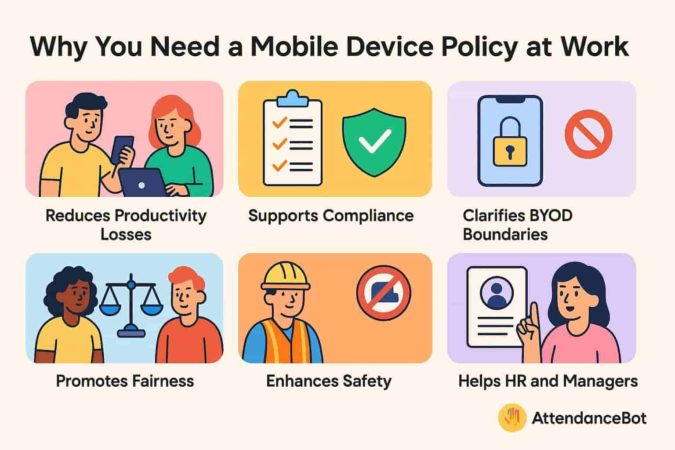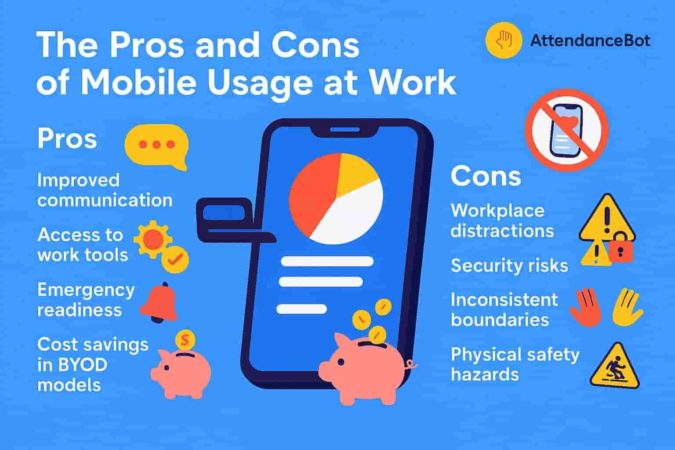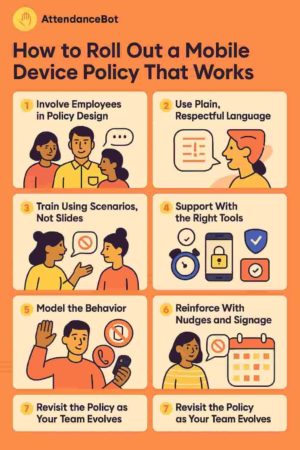Mobile phones have become an inseparable part of daily life, and the workplace is no exception. Whether it’s checking Slack, answering a quick text, or scrolling through TikTok between meetings, employees are rarely out of reach of their devices. But with convenience comes concern. As mobile use increasingly blurs the line between productivity and distraction, companies are rethinking how they manage it. That’s where mobile usage policies at work come in. These guidelines aren’t about micromanaging—it’s about creating clear expectations, protecting productivity, and ensuring fairness across teams. Whether your team is remote, hybrid, or fully on-site, a thoughtful mobile device policy can help everyone stay focused, safe, and professionally aligned.
In this blog, we’ll explore how to create effective mobile usage policies at work, what to include, how to roll them out, and why they’re essential for modern teams.
Why You Need Mobile Usage Policies at Work
A mobile device policy isn’t just a formality—it’s a proactive safeguard that helps organizations strike a balance between productivity, privacy, compliance, and culture. Whether your workforce is remote, hybrid, or on-site, having a clearly defined policy ensures everyone understands what’s acceptable during work hours and why.
Here’s why every organization—big or small—needs one:
1. It Reduces Productivity Losses
Distractions cost more than time—they affect team output, engagement, and deadlines. A clear mobile policy sets expectations around when and how personal devices can be used, helping minimize interruptions without resorting to heavy-handed monitoring.
2. It Supports Legal and Industry Compliance
Certain industries—like healthcare, finance, and education—are bound by privacy regulations (e.g., HIPAA, GDPR, FINRA) that can be compromised by mobile usage. Unauthorized photos, messages, or app access could expose companies to legal liability. A written policy helps demonstrate due diligence and protects against risk.
3. It Clarifies Boundaries in a BYOD World
With many workplaces embracing Bring Your Own Device (BYOD) models, it’s critical to outline what data the company can access, what apps are required for work, and how corporate information is protected on personal devices. This keeps both the company and employees on the same page.
4. It Promotes Fairness and Transparency
Without a policy, mobile phone use often becomes a gray area. Some employees might scroll Instagram freely while others are discouraged from checking a quick message. Clear rules create a level playing field and reduce confusion, favoritism, or tension between team members.
5. It Enhances Safety in High-Risk Environments
In manufacturing, logistics, driving, and healthcare settings, distraction isn’t just a productivity issue—it’s a safety one. A strong mobile usage policy can limit device use in specific zones or during high-risk tasks, reinforcing your commitment to employee safety and compliance with OSHA or similar standards.
6. It Protects Sensitive Company Information
The rise of mobile apps makes it easier than ever to access internal systems remotely. But without password protection, VPNs, or remote-wipe options, personal phones can be a weak point in your data security posture. A policy that includes mobile security standards (e.g., device locking, use of MDM software) reduces that exposure.
7. It Helps HR and Managers Handle Violations Consistently
When mobile use becomes a problem—whether it’s chronic texting, unauthorized recordings, or a safety violation—managers need a documented policy to refer to. This not only protects against claims of unfair treatment but also gives HR teams a standardized process for managing repeat offenses.

Types of Mobile Usage Policies at Work
When it comes to managing mobile phone use in the workplace, different environments require different levels of control. A flexible policy framework helps organizations tailor rules based on their operational needs, workplace culture, and legal responsibilities.
Here are the most common types of mobile usage policies—and when to use them:
1. Zero-Tolerance or Restricted-Use Policy
Best for: Manufacturing, healthcare, logistics, or safety-sensitive roles
This type of policy strictly limits or prohibits mobile phone use during working hours, except during breaks or in emergencies. It’s typically used in environments where distractions can lead to accidents, violations, or reduced performance.
Example Rules:
- No phone use on the production floor or while driving.
- Personal devices must be stored in lockers or designated areas.
- Emergency use is allowed only with manager approval.
Why it works: It minimizes safety risks and protects against liability in high-risk settings.
2. Limited-Use Policy
Best for: Retail, hospitality, administrative support, customer-facing roles
This approach allows mobile phone use during breaks or in designated non-customer areas, but restricts it during active work periods. It’s a balanced model that supports productivity and professionalism.
Example Rules:
- No phones on the shop floor, but allowed in the breakroom.
- Use of mobile apps for scheduling or work communication is permitted.
- Personal calls should be taken off the floor and out of the customer’s view.
Why it works: It supports workplace discipline without being overly strict.
3. Permissive or Trust-Based Policy
Best for: Tech companies, creative teams, marketing, and remote-first organizations
In this model, mobile use is mostly unrestricted, as long as it doesn’t interfere with productivity, meetings, or collaboration. Teams are trusted to self-manage, and mobile tools often play an active role in daily work.
Example Rules:
- Phones can be used for work apps like Slack, Trello, or Notion.
- Silent mode required during meetings.
- Excessive personal use discouraged but not tightly monitored.
Why it works: It empowers knowledge workers while respecting their autonomy.
4. BYOD (Bring Your Own Device) Policy
Best for: Organizations that allow employees to use personal phones for work tasks
A BYOD policy isn’t just about phone usage—it also covers data security, app requirements, and what happens if a device is lost or stolen. It’s essential for remote teams, hybrid workforces, and field teams using personal phones to access work systems.
Example Rules:
- Required use of company-approved apps (e.g., VPN, MDM tools).
- Employees must password-protect devices and enable encryption.
- The company reserves the right to remotely wipe business data if needed.
Why it works: It reduces hardware costs and increases flexibility while protecting sensitive data.
The Pros and Cons of Mobile Usage at Work
Mobile phones have become indispensable tools in modern work environments. They’re often used to communicate, authenticate logins, or access shared work apps. But without a defined boundary, mobile usage can disrupt focus, pose security risks, and even lead to safety concerns.
Here’s a closer look at both sides of the issue:
Pros
- Improved Communication: Phones make it easier to stay connected, especially for distributed teams or employees who are often away from their desks.
- Access to Work Tools: Many modern business tools—including Slack, Google Workspace, Microsoft Teams, and authentication apps—are optimized for mobile.
- Emergency Readiness: Employees can stay reachable for urgent personal matters, which supports work-life balance and reduces anxiety.
- Cost Savings in BYOD Models: Bring Your Own Device (BYOD) policies can lower operational costs by reducing the need for company-issued hardware.

Cons
- Workplace Distractions: Personal notifications, social media apps, and games are frequent sources of distraction. Workplace distractions don’t just happen—they’re often rooted in unchecked mobile usage. According to Udemy’s Workplace Distraction Report, 70% of employees admit to feeling distracted on the job, with smartphones topping the list of culprits.
- Security Risks: Personal devices may not be protected by enterprise-level security protocols, which increases the risk of data breaches, particularly if company emails or documents are accessed on unsecured phones. The NIST mobile device guidelines (SP 800-124 Rev. 2) recommend steps like remote wiping, strong passwords, and app restrictions to manage mobile threats. These recommendations are especially useful for HR and IT teams building BYOD-friendly yet secure environments.
- Inconsistent Boundaries: Without a clear mobile policy, employee expectations can vary widely, which may lead to resentment or uneven enforcement.
- Physical Safety Hazards: In certain work environments like warehouses, kitchens, or job sites, mobile phone usage can increase the likelihood of accidents or injuries.
Creating a mobile device usage policy isn’t about restricting employees; it’s about supporting productivity, fairness, and safety across the board.
Key Elements of an Effective Mobile Device Policy
Writing a mobile device policy isn’t just about banning distractions—it’s about building clarity and trust in the way your team works. To make your policy practical and enforceable, focus on structure, scope, and communication.
Here are the essential elements to include:
1. Clear Scope and Applicability
Start by identifying who the policy covers—full-time employees, contractors, interns, remote staff, or specific departments. Specify whether it applies to personal devices, company-owned phones, or both.
2. Acceptable and Unacceptable Uses
Rather than creating a blanket restriction, define examples of acceptable use (e.g., work-related communication, 2FA apps) and what’s off-limits (e.g., social media browsing, recording meetings without consent).
3. Designated Usage Times and Zones
Spell out where and when mobile phone use is permitted. You might allow usage during breaks, in lounges, or outside client-facing spaces, while discouraging it during meetings or on shop floors.
4. Security and Data Protection Requirements
Especially relevant in BYOD environments, your policy should address:
- Password or biometric lock requirements
- App download restrictions (e.g., no unauthorized third-party work tools)
- Remote-wipe protocols in case of lost/stolen devices
- Whether the company IT can access or audit work-related content
5. Privacy Guidelines
Clarify how the company handles monitoring, if at all. If device usage is logged (e.g., on company Wi-Fi or apps), explain what is tracked, why, and how employee privacy is respected.
6. Consequences of Policy Violations
Detail what happens if the policy is violated. Whether it’s a verbal warning, formal documentation, or access restrictions, outline a consistent process that gives managers and HR teams a fair enforcement roadmap.
7. Exceptions and Emergencies
Build flexibility into your policy by noting exceptions, such as:
- Family emergencies
- Health-related alerts
- Work-related apps that require mobile access
This helps ensure the policy doesn’t feel punitive.
8. Acknowledgement and Training
Once the policy is finalized, make it part of onboarding and annual compliance training. Require a digital or physical signature to confirm employees have reviewed and understood the terms.
How to Roll Out Mobile Usage Policies at Work
Creating a mobile device policy is only the first step. The real challenge? Ensuring it’s understood, accepted, and followed. That means combining clear communication with the right tools to support behavior change, not just enforcement.
Here’s how to roll out a mobile policy that works in the real world:
1. Involve Employees in Policy Design
Invite feedback from across the org—especially frontline staff, IT, and team leads. This surfaces practical use cases (like using phones for two-factor authentication) and makes employees more likely to support the final version.
2. Use Plain, Respectful Language
Skip the legal jargon. Your policy should read like a practical guide, not a disciplinary memo. Define acceptable and unacceptable use with clarity and empathy.
3. Train Using Scenarios, Not Slides
Introduce the policy through onboarding sessions, lunch-and-learns, or interactive workshops. Walk through real examples—like checking a text during a client call—to help people understand gray areas.
4. Support With the Right Tools
Policies are easier to follow when supported by smart systems:
- Mobile Device Management (MDM): Tools like Jamf or Kandji let IT enforce security settings (like passcodes or app restrictions) on company-issued or BYOD devices.
- Time Tracking & Productivity Software: Tools like AttendanceBot help track breaks and working hours within Slack or Microsoft Teams, making it easier to spot unstructured downtime without resorting to invasive monitoring.
- Remote Wipe & Access Controls: Solutions like Microsoft Intune let organizations manage who can access company data, and remove it if a device is lost or compromised.
These tools reinforce the policy silently in the background, reducing reliance on manual enforcement.
5. Model the Behavior
When managers take personal calls during meetings or text frequently during the workday, the policy loses weight. Leaders should follow the rules they expect others to uphold.
6. Reinforce With Nudges and Signage
A quick Slack reminder or visual sign in shared spaces can go a long way. Try gentle cues like “Phone-free zone” signs or timed reminders before meetings to put phones away.
7. Revisit the Policy as Your Team Evolves
What works in a 10-person office might fall flat in a hybrid team of 50 across time zones. Set a calendar reminder to review the policy annually—or whenever your work model changes.

Final Word on Mobile Usage Policies at Work
Mobile phones aren’t the enemy—they’re a part of how people work today. The key isn’t banning them outright, but setting shared expectations that protect focus, fairness, and data security.
By combining a clear, human-centered policy with the right tools and training, organizations can create a mobile-friendly workplace that works for everyone.
And if you’re looking for a simple way to track productivity, breaks, or even enforce time-based rules without added friction, tools like AttendanceBot offer an easy way to manage time directly from Slack or Microsoft Teams.



